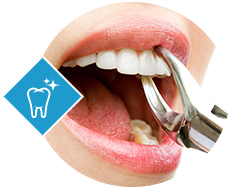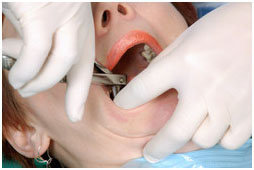
- What Is It ?
- What It's Used For ?
- Preparation
- How It's Done ?
- Risks
- When to Call an Professional
- Frequently Asked Questions
- Post Extraction Instructions
What Is It
Tooth extraction is the removal of a tooth from its socket in the bone.

What It's Used For ?
- If a tooth has been broken or damaged by decay, your dentist will try to fix it with a filling, crown or other treatment. Sometimes, though, there's too much damage for the tooth to be repaired. This is the most common reason for extracting a tooth.
- If a tooth is excessively mobile due to gum diseases.
- In children when a milk tooth is retained.
- Some people have extra teeth that block other teeth from coming in.
- People getting braces may need teeth extracted to create room for the teeth that are being moved into place.
- People receiving radiation to the head and neck may need to have teeth, in the field of radiation, extracted.
- People receiving cancer drugs may develop infected teeth. These drugs weaken the immune system, increasing the risk of infection. Infected teeth may need to be extracted.
- People receiving an organ transplant may need some teeth extracted if the teeth could become sources of infection after the transplant. People with organ transplants have a high risk of infection because they must take drugs that decrease or suppress the immune system.
- Wisdom teeth, also called third molars, are often extracted either before or after they come in. They commonly come in during the late teens or early 20s. These teeth often get stuck in the jaw (impacted) and do not come in. They need to be removed if they are decayed or cause pain. Some wisdom teeth are blocked by other teeth or may not have enough room to come in completely. This can irritate the gum, causing pain and swelling. In this case, the tooth must be removed.
Preparation
Before we do the extraction we will ask about your medical and dental histories and will take an X-ray of the area to help plan the best way to remove the tooth.
If you are having all of your wisdom teeth removed, you may have a panoramic X-ray. This X-ray takes a picture of all of your teeth at once. It can show several things that help to guide an extraction:
- The relationship of your wisdom teeth to your other teeth.
- The upper teeth's relationship to your sinuses.
- The lower teeth's relationship to a nerve in the jawbone that gives feeling to your lower jaw, lower teeth, lower lip and chin. This nerve is called the inferior alveolar nerve.
- Any infections, tumors or bone disease that may be present.
We may prescribe you the antibiotics before and after surgery. Antibiotics are more likely to be given if:
- You have infection at the time of surgery.
- You have a weakened immune system.
- You will have a long surgery.
- You have specific medical condition(s).
How It's Done ?
There are two types of extraction
- A simple extraction is performed on a tooth that can be seen in the mouth. Most of these can be done using just an injection (a local anesthetic), with or without anti-anxiety drugs. In a simple extraction, the dentist will grasp the tooth with forceps and loosen it by moving the forceps back and forth. Then the tooth will be pulled out. Sometimes the dentist will use a dental "elevator" to help loosen the tooth. This is an instrument that fits between the tooth and the gum.
- A surgical extraction involves teeth that cannot be seen easily in the mouth. They may have broken off at the gum line or they may not have come in yet. To see and remove the tooth, the dentist must cut and pull back the gums. Pulling back the gum "flap" provides access to remove bone and/or a piece of the tooth.
Surgical extractions are done with injections (local anesthesia), and you can also have conscious sedation. Patients with special medical conditions and young children may be given general anesthesia. In a surgical extraction, the dentist will need to make a cut (incision) in your gum to reach the tooth. In some cases, the tooth will need to be cut into pieces to be removed.
Here are the types of wisdom teeth, in order from easiest to remove to most complex to remove:
- Erupted ( already in the mouth ).
- Soft-tissue impacted ( just under the gum ).
- Partial-bony impacted ( partially stuck in the jaw ).
- Full-bony impacted ( completely stuck in the jaw ).
- Also, if your wisdom teeth are tilted sideways, they can be harder to remove than if they are vertical.
Risks
- Infection can set in after an extraction, although you probably won't get an infection if you have a healthy immune system.
- A common complication called a dry socket occurs when a blood clot doesn't form in the hole or the blood clot breaks off or breaks down too early.
- In a dry socket, the underlying bone is exposed to air and food. This can be very painful and can cause a bad odor or taste. A dry socket needs to be treated with a medicated dressing to stop the pain and encourage the area to heal.
- Accidental damage to teeth near the surgical site, such as fracture of fillings or teeth.
An incomplete extraction, in which a tooth root remains in the jaw — Your dentist usually removes the root to prevent infection, but occasionally it is less risky to leave a small root tip in place. - A fractured jaw caused by the pressure put on the jaw during extraction — This occurs more often in older people with osteoporosis (thinning) of the jaw.
- A hole in the sinus during removal of an upper back tooth (molar) — A small hole usually will close up by itself in a few weeks. If not, more surgery may be required.
- Soreness in the jaw muscles and/or jaw joint — It may be tough for you to open your mouth wide. This can happen because of the injections, keeping your mouth open and/or lots of pushing on your jaw.
- Long--lasting numbness in the lower lip and chin — This is caused by injury (trauma) to the inferior alveolar nerve during removal of the lower wisdom teeth. Complete healing of the nerve may take three to six months. In rare cases, the numbness may be permanent.
When to Call an Professional
Call your dentist or oral surgeon if the swelling gets worse instead of better. Also call if you have fever, chills, redness, trouble swallowing or uncontrolled bleeding in the area. If you have an infection, your dentist usually will prescribe antibiotics. If your tongue, chin or lip feels numb, tell your dentist or oral surgeon.
Also call your dentist or oral surgeon if the area of the extraction site becomes very painful. This is a sign that you may have a dry socket. If the area continues to bleed after the first 24 hours, notify your oral surgeon.
Post Extraction Instructions
These set of instructions to be follow has been provided to you to minimize the potential for any post operative problems.
Aftercare During The First 24 Hours:-
- A gauze pack has been placed at the extraction site by your dentist. Make sure you bite the gauze firmly in position for at least 45mins.
- Any salivation which occurs during this period should be swallowed and no attempt should be made to spit it out.
- On removing the gauze pack (after the above mentioned time), if bleeding persists, place another gauze pack for an hour. A moistened tea bag is an effective substitute for gauze.
- If no significant bleeding is seen after removing the gauze placed by your dentist, you may eat or drink something cold. Avoid drinking with straw, as they tend to create suction.
- Soft and cold food is preferred on the first day of extraction. Stay away from hot liquids (coffee, soups), as they tend to dissolve the clot. Alcoholic beverages should also be avoided for at least 24hrs.
- Anesthesia may cause numbness of cheek, lips or tongue. Avoid biting these soft tissues till the effect of anesthesia is over.
- Smoking in the first 24hrs may dislodge the blood clot formed at the extraction site and may thus complicate healing.
- Any swelling that does occur can be kept to a minimum by placing ice on your face in the area where the tooth has been removed. Position the ice for 10mins and then leave it off for the next 20mins. Repeat the cycle as per requirement.
- Brushing should be avoided next to the extraction site, although rest of the teeth can be brushed normally. Gentle rinsing with plain water can be done. Use of commercial mouthwashes is not advised unless prescribed by your dentist.
- Medicines should be taken as per instructions.
- Numbness due to anesthesia may be observed for 2 - 6 hrs.
- Avoid strenuous exercise or other such activities for 24hrs after tooth extraction. An extra pillow should be used while you lie down so as to elevate your head.
- Heavy bleeding if seen after first 2hrs of extraction should be informed to your dentist.
Aftercare Instructions After 24 Hours:-
- Resume normal brushing of teeth, although direct brushing of the extraction site should be avoided. Everytime you eat something, rinse your mouth with warm saline water (half teaspoon salt in a cup of water), for 2-3 days from 2nd day of extraction.
- Warm moist towel should be applied over the area of swelling.
- Patient can get back to their normal diet from the 2nd day.
Aftercare After Surgical Extraction:-
- All the above mentioned instructions should be strictly followed in case of surgical extraction.
- Swelling is very common after such extraction and may persist for 3-4 days.
If any non-resorbable sutures have been placed, they need to be removed by your dentist after 7days. The process of removing sutures is usually very easy and quite painless.


"Healthy smiles to last a lifetime"
Contact us now to schedule an appointment.

